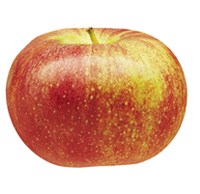Bring your dog! The Cortland Cottage is our most private lodging option. This suite is separate from the main manor house, only a short 30 feet away and with its own private parking spot. Well-behaved pets are welcome in this suite for an additional fee and subject to our policies. Our beloved French Bulldogs, Cleopatra and Pearl, will be delighted to visit and play with your companion.
Amenities include a two-person pneumatic tub, separate shower, ceiling fans, and dedicated climate control. The artwork theme for the Cortland Cottage features a mix of modern art styles celebrating its pet friendly status. And, like all our rooms, it includes the Duxiana 6006 king bed.

Cortland apples are medium to large in size, and often rather flat in shape. They are bright red and covered with dark red streaks; often they are capped with a green blush. The apple combines the sweet flavor of the McIntosh with the cold hardiness of its other parent, Ben Davis. Its crisp, finely grained white flesh is perfect for use in fresh apple preparations because it is extremely slow to brown when cut. So, it is the choice of chefs for fruit salads and is sliced thin for sandwiches, burgers, and quesadillas. It is used in lieu of crackers and paired with sweet and savory dips or flavorful cheeses. But it also shines in cooked preparations–baked into cakes, tarts, cobblers, quiches and galettes, or slow cooked to make soups, sauces, and preserves. The Cortland is exceptionally juicy with a sharp, sweet-tart, vinous flavor. Unfortunately, they do not store very will and are best eaten soon after harvest.
